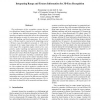Free Online Productivity Tools
i2Speak
i2Symbol
i2OCR
iTex2Img
iWeb2Print
iWeb2Shot
i2Type
iPdf2Split
iPdf2Merge
i2Bopomofo
i2Arabic
i2Style
i2Image
i2PDF
iLatex2Rtf
Sci2ools
WACV
2005
IEEE
2005
IEEE
Integrating Range and Texture Information for 3D Face Recognition
The performance of face recognition systems that use two-dimensional images depends on consistent conditions w.r.t. lighting, pose, and facial appearance. We are developing a face recognition system that utilizes three-dimensional shape information to make the system more robust to arbitrary view, lighting, and facial appearance. For each subject, a 3D face model is constructed by integrating several 2.5D face scans from different viewpoints. A 2.5D scan is composed of one range image along with a registered 2D color image. The recognition engine consists of two components, surface matching and appearance-based matching. The surface matching component is based on a modified Iterative Closest Point (ICP) algorithm. The candidate list used for appearance matching is dynamically generated based on the output of the surface matching component, which reduces the complexity of the appearance-based matching stage. The 3D model in the gallery is used to synthesize new appearance samples with...
| Added | 25 Jun 2010 |
| Updated | 25 Jun 2010 |
| Type | Conference |
| Year | 2005 |
| Where | WACV |
| Authors | Xiaoguang Lu, Anil K. Jain |
Comments (0)

